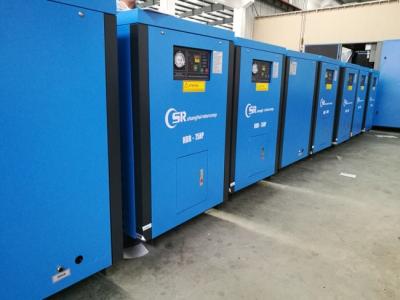Clicks: 2786
In the air compressor system, the main function of the inverter is to save energy.
So what kind of frequency converter is from the motor protection?
The frequency converter protects the motor mainly in the following aspects: over voltage protection, under voltage protection, over current protection, phase loss protection, reverse phase protection, overload protection, ground protection, short circuit protection, over frequency protection and stall protection.
Below is a brief introduction of the protection methods and effects of these types of air compressor inverters on the motor.
1. Over-voltage protection: The inverter output has a voltage detection function, and the inverter can automatically adjust the output voltage so that the motor does not withstand over-voltage. Even if the output voltage adjustment fails and the output voltage exceeds 110% of the normal voltage, the inverter protects the motor by stopping.
2. Undervoltage protection: When the voltage of the motor is lower than 90% of the normal voltage, the inverter protection stops.
3. Over-current protection: When the current of the motor exceeds 150%/3 seconds of rated value, or 200% of rated current, the inverter protects the motor by stopping.
4. Phase loss protection: Monitor the output voltage. When the output is out of phase, the inverter alarms. After a period of time, the inverter protects the motor by stopping.
5. Reverse-phase protection: The inverter can only rotate the motor in one direction, and cannot set the rotation direction. Unless the user changes the phase sequence of the motor A, B, C wiring, there is no possibility of inversion.
6. Overload protection: The inverter monitors the motor current. When the motor current exceeds 120% of the rated current for 1 minute, the inverter protects the motor by stopping.
7. Grounding protection: The inverter is equipped with a special grounding protection circuit. It is generally composed of a grounding protection transformer and a relay. When one phase or two phases are grounded, the inverter will alarm. Of course, if the user requests, we can also design the protection immediately after grounding.
8. Short-circuit protection: After the inverter output short-circuit, it will inevitably cause over-current. In 10 microseconds, the inverter will stop the motor to protect the motor.
9. Over-frequency protection: The inverter has maximum and minimum frequency limit function, so that the output frequency can only be within the specified range, thus achieving over-clock protection.
10. Stall protection: Stall protection is generally for synchronous motors. For asynchronous motors, the stall in the acceleration process must be an overcurrent. The inverter implements this protection function through overcurrent and overload protection. Stalling during deceleration can be avoided by setting a safe deceleration time during commissioning.





